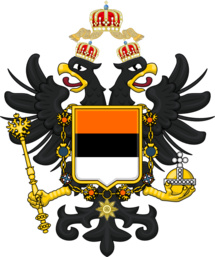Ruthenian Constitution of 2015
| Constitution of the Kingdom of Ruthenia | |
 Coat of Arms of Ruthenia
| |
| Created | 06 February 2015 |
| Ratified | 06 February 2015 |
| Location | Persenburg, Kingdom of Ruthenia Place where document signed, not location of copies |
| Authors | Emperor-King Oscar as Author Guilherme, Duke of Libertia as Revisor |
| Signers | Emperor-King Oscaras King of Ruthenia |
The Ruthenian Constitution of 2015, also know as the Constitution of Persenburg refers to the first Constitution of the Kingdom of Ruthenia, that transformed the micronation, which in practice use an absolutist system of government into a democracy. It was enacted on 6 February 2015. This first-ever Ruthenian Constitution reviewed and amended the original idea that Ruthenia should have its laws only based on uses and customs and executive, legislative or judicial decisions.
The new constitution provided for a bicameral parliament, composed of an upper house, known as the Council of State, and a lower house, known as the General Assembly. Members of the upper house are appointed by the King, while the members of the lower house are elected by the Ruthenian people. While the General Assembly held the power of legislation and the right to question the King's ministers, it did not have control over their appointment or dismissal, which was reserved to the monarch alone. The King retained an absolute veto over legislation, as well as the right to dismiss the General Assembly at any time, for any reason he found suitable. The King also had the right to issue decrees.
The inspiration for this Constitution was the Russian Constitution of 1906. Despite many reserved rights to Sovereign and the Constitution not be as liberal as it was expected, it was a major breakthrough in terms of democracy and as a basis for other legislation, increasingly comprehensive with regard to individual rights and guarantees, making no discrimination of any kind.
After the signing of the Karno-Ruthenian Compromise of 2016, the Constitution of Persenburg was maintained provisionally, until the promulgation of the Imperial and Royal Constitution of 2016.
Ruthenian government prior the Constitution
Prior to 6 February 2015, the Kingdom of Ruthenia had been an absolute monarchy, ruled by a King with autocratic powers" and his powers was never regulated since the creation of the kingdom, in 19 November 2014. In fact, the King of Ruthenia was virtually limitless. As a legislative branch of power, existed only the General Assembly, at that time a unicameral body, whose members were only aristocrats indicated by the King who, in practice, only ratified the real decisions.
Adoption of the constitution
Liberal ideals in Ruthenia were brought from Santa Cruz, then a Portuguese-speaking state ruled by Ruthenia, but was fortified only with the annexation of Duchy of Libertia by Ruthenia. The annexation doubled the population of Ruthenia, and this population accustomed for codification of their rights and guarantees could become critical to the autocratic government, although benevolent, of the King of the Ruthenians. With the calamitous situation that the micronation was in following the Plebiscite of the Language and the Scandinavian Affair, the weakened government of Ruthenia authorized the King to exercise a personal dictatorship until a constitution was approved. After a week, democracy emerged with the text approved without reservations.
Provisions
The Ruthenian Constitution of 2015 contained an introduction and twelve chapters: comprising a total of 108 articles:
- The Introduction (Articles 1-3) declared that Ruthenia is "one and indivisible".
- Chapter One (Articles 4-24) concern "the essence of the supreme sovereign power", declaring that the King possess "administrative power" and other prerrogatives.
- Chapter Two (Articles 25-31) regulate the order of succession to the throne.
- Chapter Three (Articles 32-44) concern issues of regency and guardianship, if the King is a minor. The age of majority was established at eightteen.
- Chapter Four (Articles 45-48) concern about the accession to the throne and the Oath of Allegiance to be sworn by all citizens of the kingdom.
- Chapter Five (Articles 49-50) concern the coronation and anointing of a new sovereign.
- Chapter Six (Articles 51-53) concern the many formal titles held by the Ruthenian King.
- Chapter Seven (Articles 54-57) concern the relationship of the State to the religion. The Catholic faith was declared the state religion and both the King and his or her consort were required to profess that religion.
- Chapter Eight (Articles 58-72) concern the "rights and obligations" of Ruthenian citizens.
- Chapter Nine (Articles 73-86) concern the promulgation of laws.
- Chapter Ten (Articles 87-106) regulate the modus operandi of the Council of State and the General Assembly.
- Chapter Eleven (Article 107) regulate the appointment of the Chancellor of Ruthenia.
- Chapter Twelve (Article 108) concern about the condution of the Foreign Affairs.